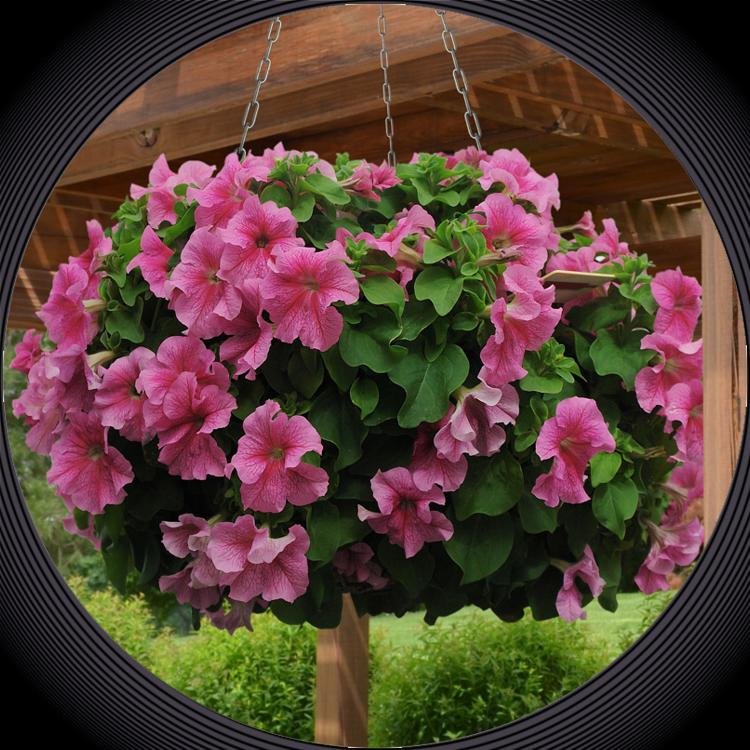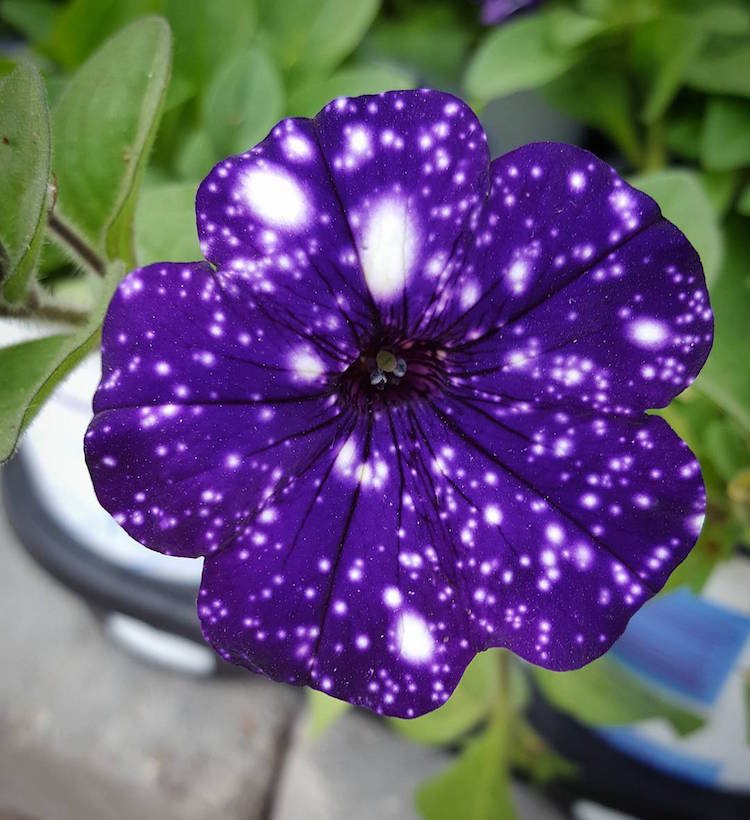Petunia variety "Ruby F1"
- Series: Espresso Frappe
- Feature of the variety: double flowers, painted in a velvety ruby color
Another hot new addition is the large-flowered petunia variety, whose flowers are adorned with a lush fringe along the edge of the petal. “Ruby” is a dwarf herbaceous dwarf shrub. Until recently, in order to grow miniature petunias, it was necessary to use retardants - chemicals that inhibit the growth of stems and shoots. But this season, the breeders pretty much pleased the flower growers, giving out two dwarf varieties at once.
The peculiarity of “Ruby” is that there is no risk of pulling out shoots. Short internodes simply prevent the bush from doing this. Due to this, the petunia turns out to be small, but lush. It looks perfect in hanging containers and is most often used as an ampelous flower. On a flower bed, dwarf varieties of petunias do not look the best way. But in a pots - just perfect. The parameters of the Ruby bush are similar to those of the Roses: the diameter is about 0.3 meters, the height is a little more than 0.2 meters.

Petunia variety "Burgundy White Edge"
- Series: Spherica
- Feature of the variety: one of the newest series of herbaceous flowering dwarf shrub, which combines the maximum positive qualities of its predecessors.
If you're looking for something versatile for your site, congratulations: you've found it. The "Spherica" series is rightfully considered the most versatile, since such shrubs can be planted in hanging pots or containers, carrying out vertical gardening, and in flower beds (in the traditional way), and in the form of green flowering borders, framing sidewalks or paths in the country with semi-shrubs. around the country house.
Petunia is known to be afraid of rain. The varieties with which we are familiar for a long time, unfortunately, lose their original appearance after precipitation. They become duller, "bruised", look noticeably tired. But the variety "Burgundy White Edge" in this case is an exception to the rule. Yes, rain spoils the appearance of its flowers no less than other varieties of petunias. But at the same time, this variety quickly takes shape and restores its original appearance.
Petunia variety "Rose White Edge"
- Series: Spherica
- Feature of the variety: suitable for vertical and horizontal gardening; blooms quite early and blooms for a very long time
As another representative of the Spherica series, this petunia combines all of the above qualities. She is not afraid of rain and restores the appearance of flowers quite quickly. It looks great in hanging containers and looks just as good in a flower bed and in a mixborder. Designers often use this variety for border decoration. The herbaceous shrub forms a hemisphere. The bush is collected, lush, voluminous.
The color range of inflorescences deserves special attention. The flowers are bright pink in color and have white spots around the edges of the petals. It seems as if the plant was accidentally sprinkled with bleach, after which a snow-white border appeared on the surface of the inflorescences. It is noteworthy that this border appears fragmentarily, and does not encircle the entire flower in diameter. The flowers themselves are quite large: they are about the same size as the Burgundy White Edge variety, which has a deeper and darker color.
New varieties of petunias
 |
Spherical
Description:
|
 |
Night sky
Description:
|
 |
Sophistry
Description:
|
 |
Glafira
Description:
|
 |
Bonanza
Description:
|
Reproduction of frillithunia
This plant, being a hybrid, does not form viable seeds. They are obtained in breeding centers. At home, frillithunia can be propagated by cuttings. Since petunia is a perennial plant, before the onset of frost, it can be brought into a room with a temperature of +5 to +10 degrees, cut off the aerial part and removed until spring. With an increase in temperature and daylight hours, the plant will start to grow.
Sowing seeds
All types of petunias have very small, so-called fine-dust seeds. In order for them to ascend, you need to do the following:
- prepare a shallow (5-6 cm) container with light neutral soil;
- pour warm water on the ground;
- place seeds on the surface of the soil, without covering them with earth. The distance between the seeds is 3-4 cm;
- cover the container with foil, glass, or better with agrofibre to maintain the necessary moisture in the container.
Frillitunia develops more slowly than regular petunias, so you need to sow its seeds earlier. As a rule, this should be done in late January - early February.
After 7-10 days, the seeds will germinate and certain conditions must be created for the next phase of seedling development.
Growing seedlings
Frillitunia grows with a long day of light lasting at least 14 hours. Therefore, germinated seeds for further development are illuminated with fluorescent or special phytolamps. Lamps are placed at a height of 7-10 cm from the shoots.
After the appearance of the second pair of true leaves, the seedlings dive into the seedling boxes. Previously, this operation cannot be performed: frillithunia has very delicate roots, they will not tolerate an early pick. For such capricious and delicate plants, a double pick is used: first into cassettes or seedling boxes, then they are transferred into individual containers.
In the process of growing seedlings, the seedlings are treated with root and phytosporin.

Important! All operations with solutions are carried out using a pipette or syringe, being careful not to get moisture on the stem and leaves!


